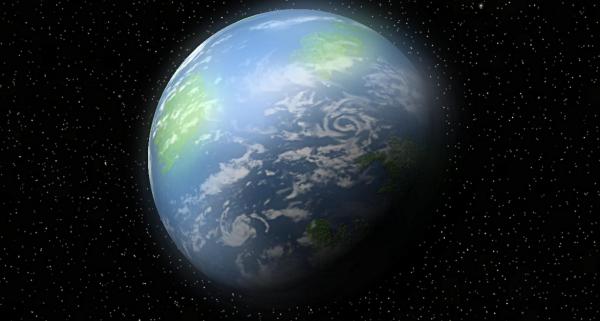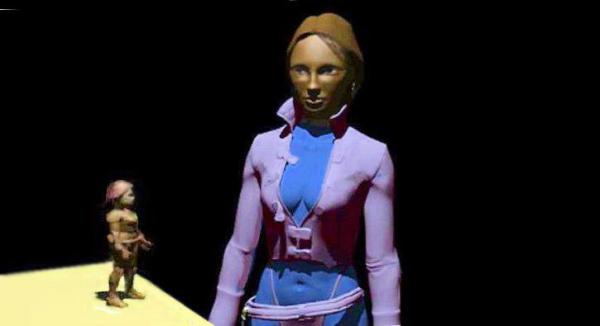BY LETTER
Blefuscu
Galactography > Regions of Space > Middle Regions/Hinter-regions
Galactography > Systems and Worlds > Systems & Worlds A - B
Galactography > Systems and Worlds > Systems & Worlds A - B
Superterrestrial world with a population of minaturised humans | |
 Image from Steve Bowers | |
| Originally a dry, anoxic superterrestrial, this planet has now been terraformed and has a helium-rich but breathable atmosphere | |
Blefuscu - Data Panel | |
| Star | JD 788901101 |
|---|---|
| Type | Xeric SuperGaian, (modified with imported ice to increase surface water cover) |
| Luminosity | 0.863 x Sol |
| Distance from Sol | 2101 ly (epoch 2000) |
| Planet | Blefuscu |
| Mass | 4.9 x Earth |
| Diameter | 18600 km |
| Surface Gravity | 2.3 gees |
First reached in 6110 AT by a Nisse colony ship, this large world in Pyxis, 2105 ly from Sol, was originally a dry SuperGaian type world with very little water. Several thousand water-ice outer-system objects were diverted to impact with the surface of this world, increasing the ocean cover to 50%. The high gravity of this world means that elevation differences between highlands and lowlands are quite small, and the ocean is generally shallow. There are fifteen major continents, with many smaller islands.
The nitrogen/helium/carbon dioxide/neon atmosphere was modified over the next six hundred years to contain enough oxygen for easy respiration, at which point it became possible for the colonists to occupy the surface without breathing apparatus.
Blefuscu has a large land surface area, more than three times that of the Earth, and the Blefuscans are one-eighth as tall as normal humans; 22 cm average. As a consequence of this there are many small but relatively populous nations on the fifteen continents, subcontinents and major islands. This has resulted in a complex political situation on this world, rapidly changing in line with their faster experience of time.
The Blefuscans
Already a highly modified species, the miniaturised human of Clade Nisse were further modified to live in the unusually high gravity of this planet. Only 22 centimetres tall on average, Homo tantilis Blefuscu are strongly muscled and compact.A Blefuscan has a short thick neck that supports a small head, with a highly optimised neural structure within the skull to allow normal human-level cognitive abilities.
Their heads are the same size as other members of the Nisse clade, but their bodies are shorter and stockier, an adaptation to the high gravity of their homeworld. Many or most Blefuscans have adapted their genetic clade template to make their hair grow into keratin helmets and caps, to protect against falling objects and the heavy raindrops that fell from the low clouds. They also have toughened their knees and elbows as a common high-g adaptation against falls.
 Image from Steve Bowers | |
| A Blefuscan individual converses with a normal-sized nearbaseline human | |
Due to the helium content of the atmosphere and their short vocal chords, they have unusually high-pitched voices, which drop an octave or two when breathing an Earth-standard atmosphere. Their small size allows them to cope with the higher gravity well, although their reflexes and sense of subjective time need to be considerably faster than those of humans living on planets with lower gravity. The high gravity acts to rapidly pull any fallen object to the floor, so a Blefuscan who falls over or drops something must react quickly or damage will almost certainly result. Blefuscans have also optimized their angelnetting for fall protection in built up areas. Though societies on Blefuscu did use backup technology even during the least stable parts of their history, backups apparently remained sporadic across multiple years and even then, restricted to their traditional clade body.
In addition, Blefuscuans changed the old feature of miniaturized Nisse physiology, in which portions of the memory and personality were stored in external structures to compensate for their reduced brain mass. Blefuscuans have maintained their traditional body design so that, for significant fractions of the population, personal identity has stayed deeply integral with their smart infrastructure, and the boundary between the two has remained blurred to varying degrees through their history until around 9000AT. This strong Blefuscu affiliation/tradition for blurring personal identity and smart infrastructure, and integrating the functions of memory and other cognition into the external structures which served them, may have further contributed to development of the less favored "servant-class" in their societies before 8000AT, despite their ancestors originating in Sephirotic cultures.
Slave-ownership
One development on this planet, widely condemned across the rest of the Sephirotics once discovered, was the practice of forced domestic servitude and serfdom among many of the major polities. The practice began following a rapid but widespread series of wars which damaged much of the local autonomous industry and disrupted social structures. Local propaganda described "catastrophic failures of the automated infrastructure through mismanagement by other nations", though the cause of these wars is unconfirmed by other sources. In 7988, A polity calling itself the Tramecksan Empire emerged victorious from the conflict and absorbed several smaller nations, and declared that the defeated population would henceforth be subservient to the victors, to become reclassified as indentured servants, debt slaves, and 'converted bio-bots' within the redesigned laws and software of the empire's autonomous infrastructure. Political historians across the Terragen sphere strongly contest the extent to which mass labour was needed after the early years, or ever, despite the Tramecksan insistence of it as a necessity, as most automated infrastructure could have regrown within less than a decade.At this time the only transapient in the system was a Non-Sephirotic-aligned Omega class ISO, the Jambudvipa, orbiting the star at 0.2 AU and deeply committed to ecumenism. This entity has been found on record for expressing er concern at this cultural atavism, but had decided to refrain from intervention in the affairs of this world as long as the indentured servants were "treated well", while promising to aid in defending the system from Sephirotic intervention on the principle of 'political independence'. The Tramecksans adopted a policy of "paternalistic indentured servitude", where the owners of indentured servants were "responsible in law for the well-being of their human property". By the time independent groups in nearby systems learned of these practices and attempted to intervene, centuries had passed. Several centuries more passed before enough political will had built to mount 'intervention missions', which were ultimately sent back or blocked from full access by the Jambudvipa. Though interventionist groups had repeatedly brought legal actions against the Jambudvipa, none had succeeded while e governed the system.
According to the historical records found by later missions, slaves did not routinely receive psychosurgical intervention. Slave owners claimed that this was a sign of good ethical practice, though some have contended that it was due to a cultural desire for slaves to feel like their condition was a punishment for their culture's "crimes". In spite of this those that did disobey were subjected to psychosurgery to implant strong loyalty to their owner as well as submissive tendencies. Though no sources exist to contradict the Tramecksan records,like a report from the Office of Biobot Administration in 8004AT saying "servants were obedient and performed their duties well, especially as those duties were not too onerous given that most tasks were automated to a greater or lesser extent." Some historians remain skeptical that such conditions did not include widespread abuses, given similar conditions in previous eras. Given the possible sophistication of the accused revision in historical records, historians cannot rule out the possibilities of cultural genocide or other crimes against sophont beings which was then removed from planetary records.
The Golden Caps
Tramecksan sources say forms of sophont labor were status symbols for the Blefuscu. The system had originated as a way for the Tramecksan empire to assert their dominance over the losers, deprive them of citizenship, and perpetuate their own power; this practise continued within that empire as a marker of status and respectability for the owners, who had altered their hair into golden or white keratin helmets as fall protection. Most servants and 'bio-bots' were drawn from 're-educated' polities under military or economic occupation by that empire, or from polities which were economically indebted to Tramecksans or their allies.High status masters might own a small army of "bio-bots", who carried out many responsible duties within their households. According to the much sparser Tramecksan historical records on the slaves themselves, "Indentured Servants and bio-bots who were well-cared-for were particularly good markers of respectability; since the well-being of the servants was the responsibility of the masters, and many servants did not, or could not actively desire change." whether this was true in practice is unknown.
There exist some later records which show a small number of slaves were 'freed' by their masters; a few freedpersons apparently went on to hold political office, but none of these are on record to have permanently effected change on the system. Historians theorize that the general absence of such records indicates either a deliberate destruction and revision of the history and records by the Tramecksan regime or some selective blockade on surveillance at the time from their unusually centralized surveillance and backup systems during this period. Others still contest that the Blefuscu "ideal servitude" actually occurred as the Tramecksan societies described.
Paternalistic servitude and 'bio-bots' persisted in various forms on different parts of Blefuscu for more than five hundred years, even after the Tramecksan empire dissolved, despite efforts by various liberation movements (including the Pansophontists) to free them. A single leaked message from a hijacked broadcast station revealed that, during a series of conflicts which were the first slave revolts and work strikes on record, the system finally dissolved and returned to a more equitable form of post-scarcity society. Records found later in hidden data caches confirmed this. It is also possible, however, that previously unrecorded revolts had occurred and that the revolt on record had little lasting effect on the system. The actual cause may have been that over time the countries which did not practice slavery or psychosurgery became more influential and the worst practices were outlawed and prosecuted, even if the records of these events were destroyed. By the 8400's the system of bio-bot slavery became an anachronism, according to Jambudvipa and several intervening Sephirotic ships, and officially, was recreated only in museums to guard against the possibility of it happening again.
Related Articles
Appears in Topics
Development Notes
Text by Steve Bowers
Initially published on 15 August 2011.
Article revised 2022/2023 by OA editors
To download Blefuscu for Celestia, click this link and download it into Celestia's Extras folder
then follow this CEL link Somewhere near Blefuscu
You can download Celestia from here
Initially published on 15 August 2011.
Article revised 2022/2023 by OA editors
To download Blefuscu for Celestia, click this link and download it into Celestia's Extras folder
then follow this CEL link Somewhere near Blefuscu
You can download Celestia from here






